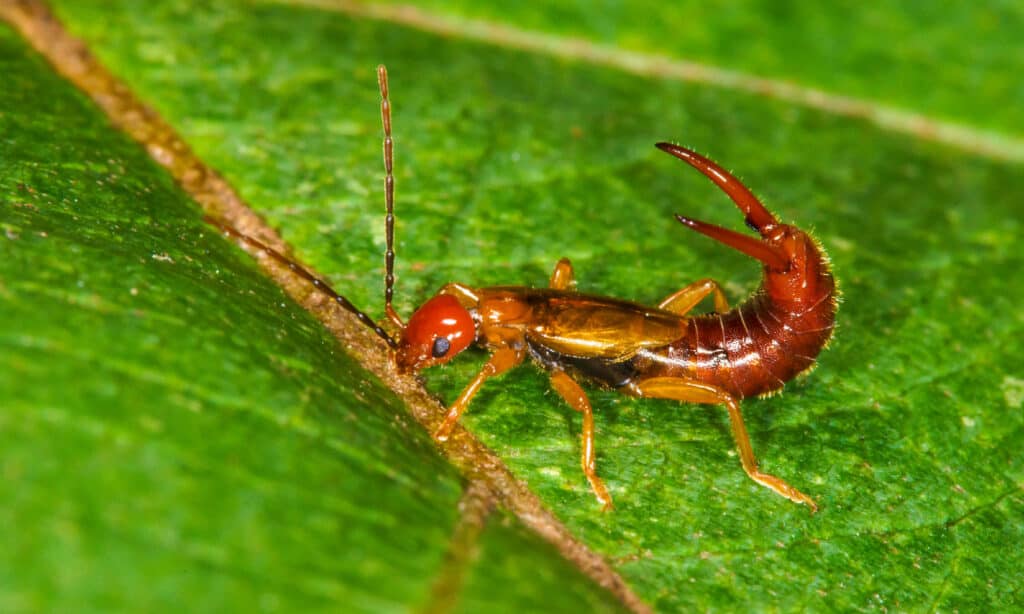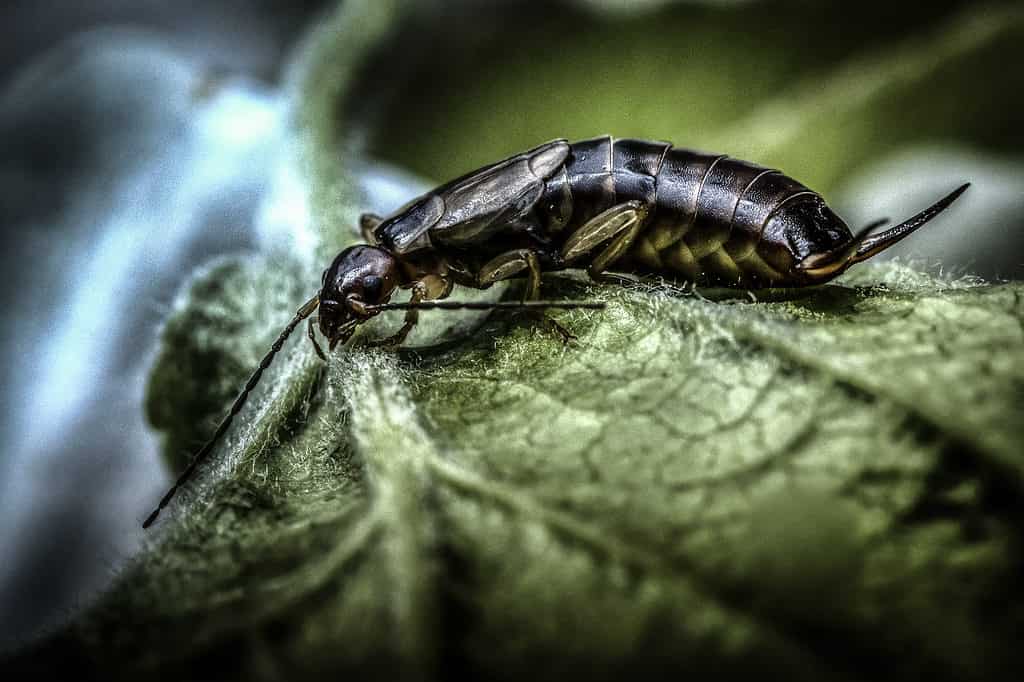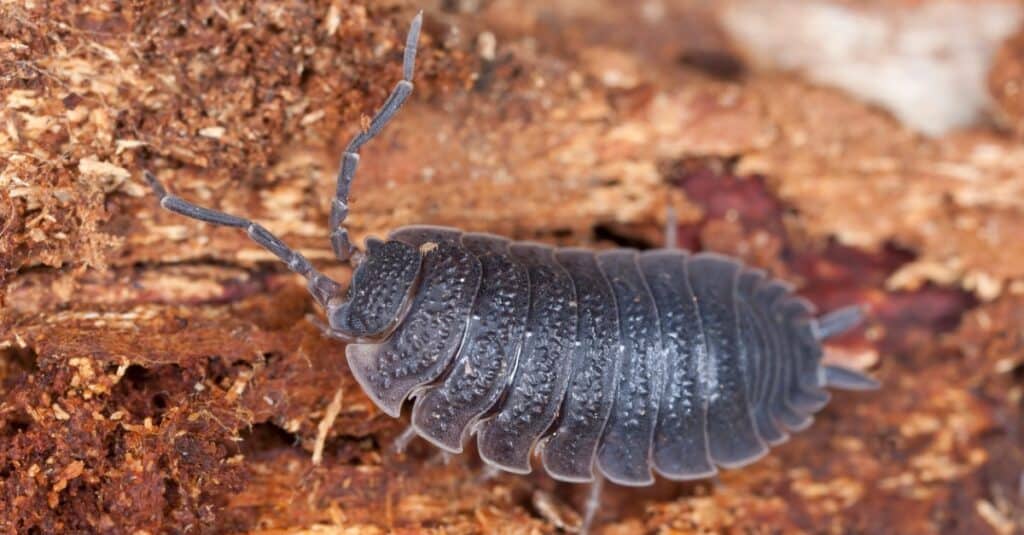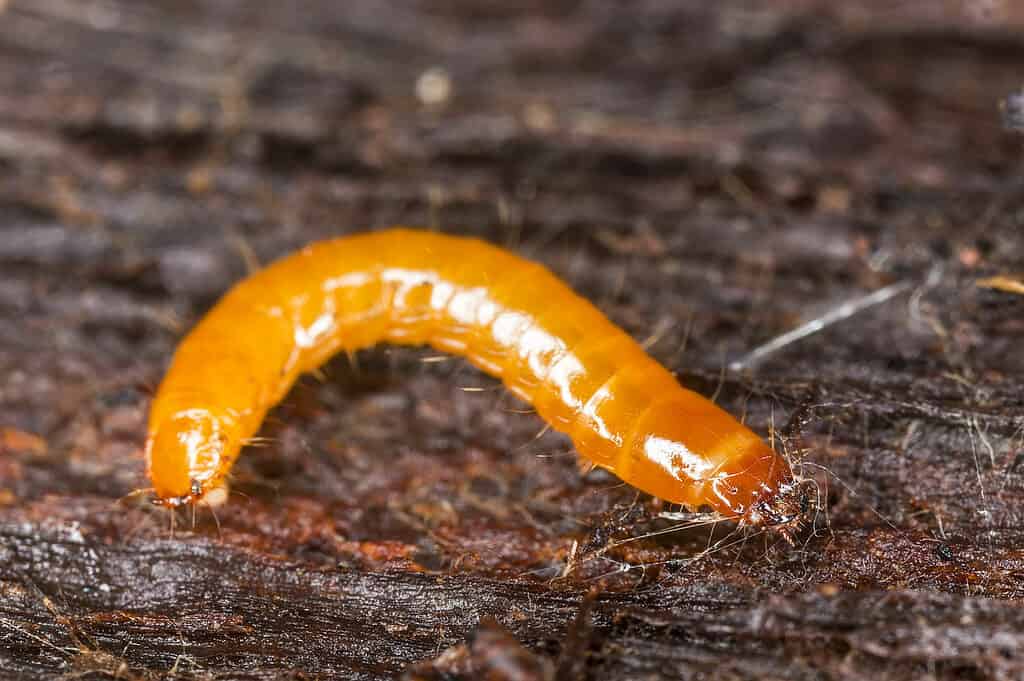If you have ever found a creepy-crawly creature in your home and thought to yourself, ‘Ew, it’s a centipede!’ you’re not alone. Centipedes are one of the most common household pests and one of the most feared. With their long, segmented bodies and dozens of legs, they’re not exactly cute and cuddly.
But what if we told you there are a few bugs out there that can look remarkably like centipedes yet aren’t related to each other? That’s right – plenty of different bugs can be mistaken for centipedes.
Below, we’ve rounded up ten of these bugs that look like centipedes, with indications on how to tell them apart. So, the next time you spot a creepy crawly bug in your home, take a closer look – it could be one of these centipede imposters!
1. Earwigs

Earwigs are nocturnal and prefer damp, dark places to hide during the day.
©Suede Chen/Shutterstock.com
With about 2,000 species, earwigs are members of the arthropod phylum that can be found worldwide, except in Antarctica. They are small insects with smooth, shiny dark brown or black bodies. They’re known for the pair of pincers on their abdomens. Earwigs are nocturnal and prefer damp, dark places to hide during the day. They are omnivorous and feast on plants, insects, flowers, and even crops, which makes them pests in some regions.
The name ‘earwig’ comes from an old European superstition implying that the insects crawl into people’s ears while they sleep and wreak havoc on their brains. Of course, there is no objective evidence of this happening. In reality, even though they sometimes get into people’s ears, they don’t cause significant harm.
Even though earwigs look like centipedes, they are not the same. Centipedes have more legs and much longer bodies than earwigs. Earwigs also have a pair of pincers on their rear ends, while centipedes don’t. Centipedes are predators and tend to have more aggressive behaviors than earwigs. On the other hand, earwigs are primarily scavengers and feed on decaying matter. Observing their habitats makes it easy to tell earwigs apart from centipedes. Centipedes thrive in various habitats, including under rocks, in homes, and in trees. Earwigs, however, tend to live in moist and dark places such as rotten wood or leaf litter.
2. Millipedes

Millipedes range from one-half inch to 14 inches in length.
©Gerry Bishop/Shutterstock.com
Scientifically classified as Diplopoda, millipedes are called “thousand-leggers.” They belong to the Arthropoda phylum, and there are more than 10,000 named millipede species worldwide, except in Antarctica. They have segmented bodies with two pairs of jointed legs found on most body segments. Millipedes range from one-half inch to 14 inches in length. Most are black or brownish, but some species display bright colors.
Both centipedes and millipedes have cylindrical or flattened bodies. However, millipedes have two pairs of jointed legs per body segment, and centipedes have only one pair. Millipedes are typically much slower than centipedes, which move rapidly and erratically. They also feed on different food sources, with millipedes being detritivores. They eat decaying plant matter, while centipedes are carnivores, preferring insects and other small organisms.
The number of legs can help differentiate between the two species. Millipedes have more legs than centipedes, with most species having around four pairs of legs per segment. In contrast, centipedes usually have only one pair of legs per body segment. Size-wise, centipedes are smaller and have slender bodies, while millipedes are longer and have plumper bodies. This also applies to their legs, with centipedes having longer legs than millipedes.
3. Firebrats

Firebrats are usually found near warm, moist areas, such as furnaces, fireplaces, and boilers.
©iStock.com/Wirestock
Another crawly bug that looks like a centipede is the firebrat. Technically known as Thermobia domestica, this small hexapod has a fish-shaped body. Firebrats are wingless and are closely related to silverfish. They are distributed throughout most parts of the world and prefer places with higher temperatures and moist conditions for survival.
The creature feeds on carbohydrates and starches, which act as protein sources. They may eat paper goods, stain clothing, or even contaminate food, but they pose no threat to humans. So, how do you tell them apart from centipedes? Firebrats are usually dark gray or black, while centipedes are brown or black.
Typically, firebrats are smaller than centipedes. They can grow about ½ inch long, while centipedes are long and slender, growing up to 12 inches. While centipedes prefer damp areas and feed on insects and other small animals, firebrats are usually found near warm, moist areas, such as furnaces, fireplaces, and boilers. When living outdoors, they will take shelter in decaying wood, piles of leaves, or rocks to keep warm.
4. Caterpillars

Caterpillars are the larvae of moths and butterflies.
©Catherine Eckert/Shutterstock.com
Caterpillars are the larvae of moths and butterflies. Depending on the species, they range in size from 2mm up to 8 inches and come in various colors. Some caterpillars have bright colors and patterns, while others are drab colored and blend into their surroundings for camouflage. Caterpillars can move quickly by undulating their bodies like a centipede, making them look deceptively centipede-like.
However, despite their similar-looking bodies, they are distinct in morphology, diet, and development. For example, caterpillars have plump, round bodies. They generally have small antennae, and some species also sport horns. Comparingly, centipedes have flatter bodies. Their heads are also more distinct, and their antennae stick out much further from their body. Besides, caterpillars are herbivores and have fewer legs than centipedes, which are carnivores. And lastly, caterpillars have soft exoskeletons, while centipedes have tough exoskeletons.
5. Silverfish

Silverfish have two sworn predators – centipedes and spiders.
©2Dvisualize/Shutterstock.com
Silverfish or Lepisma saccharinum are small, wingless members of the arthropod phylum. They are considered primitive insects, typically 0.5-1 inch long. They are nocturnal creatures with a lifespan of three years. Silverfish get their name from their silvery light gray color and fish-like wiggling movements. They have long, thin antennae that can be regenerated if lost. Centipedes, on the other hand, aren’t capable of growing their antennae back.
Silverfish survive by feeding on carbohydrates such as sugars and starch, which they find in book bindings, clothing, paper, coffee, and flour. In contrast, centipedes feed primarily on insects. While silverfish lay their eggs in groups of around 50, centipedes lay them singly. Silverfish have two sworn predators – centipedes and spiders.
6. Woodlice

Woodlice or sow bugs are isopod
crustaceans in the order
Isopoda.
©iStock.com/Henrik_L
Woodlice or sow bugs are isopod crustaceans in the order Isopoda. More than 3,700 woodlice species have been identified worldwide. They are called this way because they’re often found in wood. Woodlice have a shell-like exoskeleton which they molt as they grow, while their flattened bodies consist of multiple segments, equipped with seven pairs of legs. Their adaptation to terrestrial life allows them to thrive in different environments, from marine zones to deserts. Being dark brown or black and measuring around 0.5 inches long, silverfish are popular terrarium pets.
Woodlice are also studied for their unique ability of nutrient cycling, which aids in water and soil conservation. Their use as a beneficial species to the environment has made them popular among scientists and hobbyists. Woodlice can be easily identified from centipedes due to their pill-shaped body and their size. Moreover, woodlice are detritivores, unlike centipedes which are carnivorous.
7. Pill Bugs

Pill bugs feed on decomposing plants but can also eat living plants and wood fibers.
©Mauro Rodrigues/Shutterstock.com
Another bug you’re likely to come across that looks similar to a centipede is the pill bug. Native to the Mediterranean Basin, pill bugs are arthropod crustaceans related to crabs, shrimp, and lobster. They are also known as roly polies, doodlebugs, and cheese logs. Pill bugs can use conglobation as a defensive mechanism, which means they can curl up into a ball. They usually grow about 0.5-1 inch long and are dark gray or black with seven pairs of legs.
Pill bugs have short, stout bodies that can help you distinguish them from centipedes. They feed on decomposing plants but can also eat living plants and wood fibers. Unlike centipedes, which prefer damp places, pill bugs are usually found in dry, dark areas like under rocks and logs.
8. Pauropods

Pauropods are found in soil and leaf mold.
©Andy Murray / CC BY-SA 3.0 – License
Pauropods can be easily confused with millipedes and centipedes due to their similar appearance. They range in color from gray or brown to bright colors. These tiny bugs have cylindrical, soft bodies, making it even more challenging to differentiate them from similar-looking creatures.
Pauropods are found in soil and leaf mold, so you’re unlikely to stumble upon them. More than 800 pauropod species are known for their ability to crawl quickly and change direction just as swiftly when disturbed. However, unlike centipedes, pauropods do not bite, sting, or harm humans and animals.
Pauropods are beneficial to gardens. They feed on decaying matter and help break it down, adding nutrients to the soil. They also eat other pest bugs and help keep the ecosystem balanced.
9. Pseudocentipedes

Pseudocentipedes are primarily herbivores and prefer to inhabit moist areas.
©Soniamartinez / CC BY-SA 4.0 – License
Also called garden centipedes, pseudocentipedes are arthropods that live in the soil and belong to the class Symphyla. These creepy-looking bugs have no eyes and white, almost transparent bodies. They use their long, segmented antennae as sense organs and navigation tools. Over 200 pseudocentipedes species are found worldwide and typically have a four-year lifespan.
Pseudocentipedes are primarily herbivores and prefer to inhabit moist areas. They feed on decaying plants and other organic matter. As mentioned, pseudocentipedes are soil-dwelling insects, and they are typically found about 20 inches underground. Regardless, they are fast movers.
Like centipedes, pseudocentipedes have segmented bodies with one pair of legs on some segments. This provides them with a centipede-like appearance and lends credibility to their name. Despite that, pseudocentipedes aren’t closely related to centipedes. They aren’t also known to cause any harm to humans, but they are harmful in agricultural settings.
10. Click Beetle Larvae

Click beetle larvae have elongated, slender, shiny bodies with hard exoskeletons.
©Henrik Larsson/Shutterstock.com
Click beetle larvae, also called wireworms, have a shape that could easily be confused with geophilic centipedes in particular. They have elongated, slender, shiny bodies with hard exoskeletons. They have a brownish coloration and range from ½ to 2-½ inches long. They also have three short pairs of legs on their thoracic segments. These creatures feed on decaying vegetation and the roots of plants, particularly crops such as potatoes, corn, and wheat. Despite their similarity to centipedes, they have no venom and pose no threat to humans.
Up Next:
- The 10 Biggest Centipedes in the World!
- 11 Colorful Bugs That Look Like Ladybugs
- Types of Centipedes: 8 of the Most Fascinating Centipede Species
- Are Centipedes Poisonous or Dangerous?
The photo featured at the top of this post is © W. de Vries/Shutterstock.com
Sources
- The Pet Enthusiast, Available here: https://thepetenthusiast.com/bugs-that-look-like-centipedes/#6-Pauropods
- Western Exterminator, Available here: https://www.westernexterminator.com/blog/5-common-bugs-lots-legs/
- University of Minnesota Extension, Available here: https://extension.umn.edu/insect-relatives/sowbugs-millipedes-and-centipedes
Thank you for reading! Have some feedback for us? Contact the AZ Animals editorial team.






